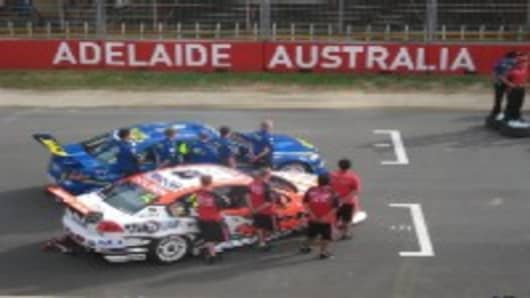In December, the U.S. government doled out $17.4 billion to GM and Chrysler. They wanted more, but the Feds wanted to see more from them as well. The Treasury has told GM to prepare for bankruptcy, while Chrysler has days to complete a proposed alliance with Fiat. If no agreement is reached, Chrysler executives say the company may face liquidation.
Ford , on the other hand, has been relatively quiet since its Washington appeal. Instead, Ford toiled diligently on a turnaround plan, which apparently, works, as it now no longer needs a Federal funds.
Results on the racetrack have also mirrored the fortunes of automakers.
In Australia’s V8 Supercar Championships, Ford dominated in the season’s opener at Clipsal 500 via Team Vodafone’s Jamie Whincup, who carried on where he left off last year, winning both races in Adelaide.
And in the following week at Melbourne, Whincup’s teammate, Craig Lowndes flew the flag for Ford and Team Vodafone by winning the races in the support category when the city hosted Formula 1.
GM, under the guise of Holden, was left counting their missed opportunities and rueing what could have been. As a car manufacturer, Holden hasn’t made a profit since 2004.
And speaking of Formula 1, executives at Honda must be kicking themselves for withdrawing from the motor sport’s premier event. Sure it might have saved them $500 million a year. But its reincarnated form, Brawn GP, have wowed spectators and rivals alike with victories at Albert Park and Sepang. And yet, team members and drivers are doing very much the same thing as before, when under Honda.
It’s not about the engine. McLaren’s using the same kind and they’re way back in the field. Rather, it’s the aerodynamics package and diffusers that everyone says is giving Brawn the advantage. And that was developed by Honda. Honda had invested huge amounts of capital in its wind-tunnel, simulator and specialist equipment back at its headquarters in Brackley, Northamptonshire.
So the question remains. Should car manufacturers stay in motorsports even if they’re suffering financially? When Car and Driver ran an April Fool’s day article that said President Obama had ordered GM and Chrysler out of NASCAR, it frightened both fans and NASCAR insiders. And had Honda stuck with their involvement in F1, they, arguably could be reaping the benefits of their work prior to the season.
But make no mistake. Despite successes on the racing front, cost cutting is still the name of the game. Brawn, after its Melbourne win, announced 270 job cuts. Toyota's F1 team is reportedly flying economy. But the case for persisting in motorsports is still very strong.
CNBC.com Slideshows
Crowd numbers may have dropped, but tens of thousands of people are still showing up. Television viewership has hardly fallen, considering it’s still a cost-efficient way of watching the races.
And of course, when Richard Branson chose to pledge his lot with Brawn GP, which is said to cost him $250,000 a race, he witnessed an immediate return on his investment. After all, Formula One Administration awards television advertising revenues in accordance to how teams end up in the Constructors championship.
And the higher you’re up on the table, the bigger your share of the revenue. With Brawn leading both Drivers and Constructors championships at the moment, one can only marvel at the serendipitous track drama and Branson’s business acumen.


